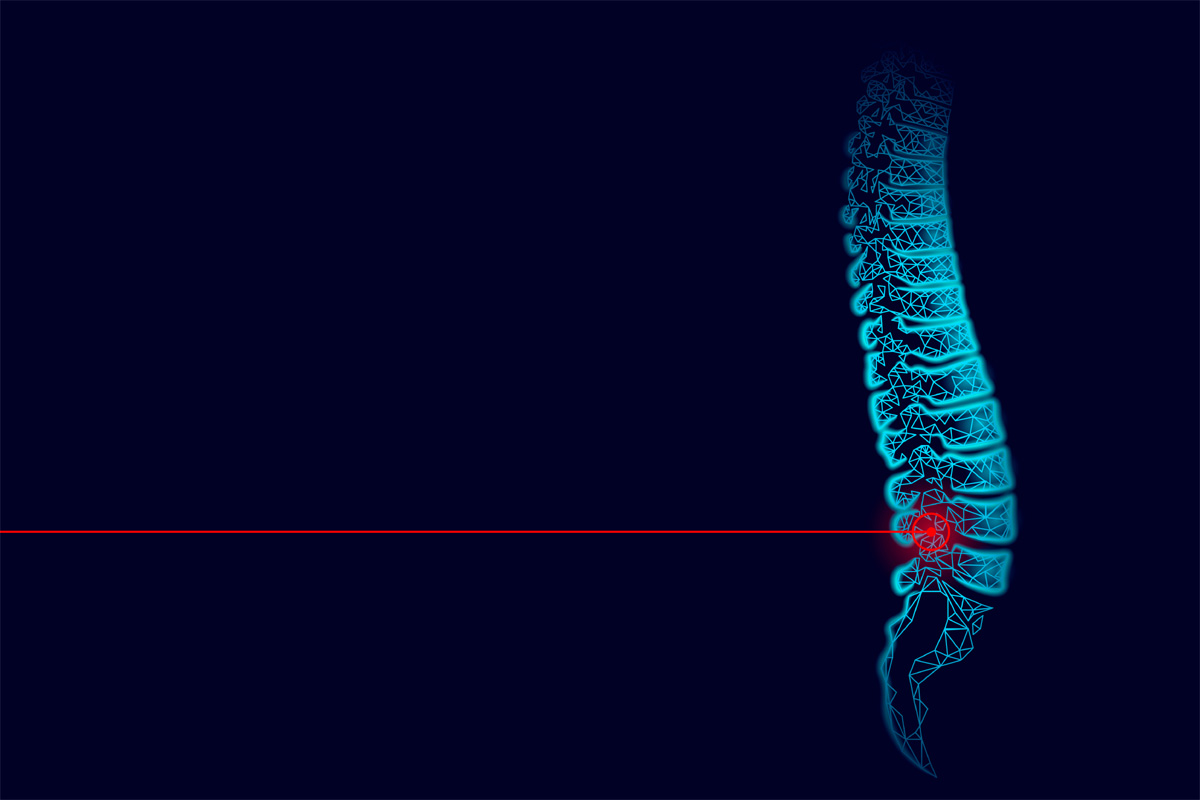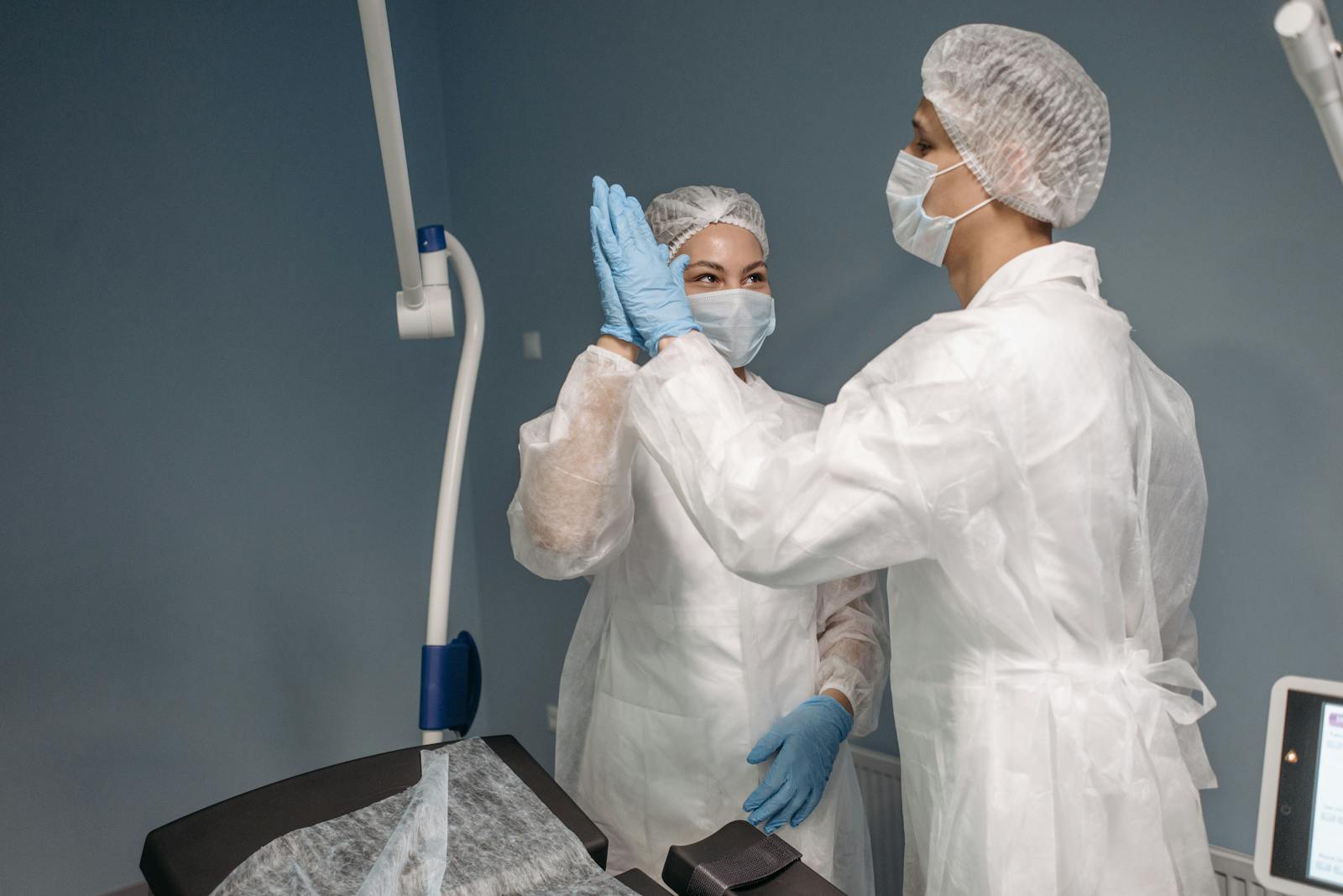Laser spine surgery is a minimally invasive, precise procedure offering relief from herniated disc-associated pain. The procedure involves application of laser technology to remove or shrink the troubling disc portion, effectively relieving nerve pressure. Its notable advantages include improved outcomes, shortened recovery times, reduced collateral tissue damage, and less postoperative discomfort. However, potential complications such as infection or nerve damage may occur. It’s paramount to discuss benefits, costs, and potential risks with healthcare providers. Understanding personal factors influencing surgical success can lead to more informed decisions. Further exploring this topic can provide deeper insights into this advanced treatment option.
Understanding Herniated Disc
Frequently encountered in clinical practice, a herniated disc, also known as a slipped or ruptured disc, refers to a condition where the soft, jelly-like substance from the inside of the disc protrudes through a tear in its tough exterior, exerting pressure on the surrounding nerves and causing significant pain. This condition is intricately tied to disc anatomy basics. The disc, positioned between each vertebra of the spine, consists of two parts: a tough outer layer called the annulus fibrosus, and a gel-like interior known as the nucleus pulposus. A herniated disc occurs when the nucleus pushes through a tear in the annulus fibrosus.
Non surgical treatments for herniated discs primarily aim to relieve pain and inflammation, improve mobility, and prevent further damage. These may include physiotherapy, pain medication, corticosteroid injections, and lifestyle changes such as maintaining a healthy weight and regular exercise. Some patients may benefit from acupuncture or chiropractic care. It is important to note that while these alternative treatments can effectively manage symptoms, they do not repair the herniated disc itself. Hence, they are typically part of a complete treatment plan which may or may not include surgical interventions.
Laser Spine Surgery Explained
Laser spine surgery, a minimally invasive technique, is increasingly used to treat herniated discs. The procedure involves the use of a laser to remove or shrink the portion of the disc that is causing nerve compression. This discussion will explain the intricacies of the operation, along with its application for herniated disc cases.
Understanding Laser Spine Surgery
Delving into the domain of medical advancements, one cannot overlook the transformative role of laser spine surgery, a minimally invasive procedure specifically designed to treat conditions such as herniated discs. This therapeutic intervention leverages the advancements in laser technology, making it possible for a surgeon to operate with the utmost importance. The surgeon’s expertise plays a vital role in ensuring the success of the procedure as the laser needs to be directed accurately to the affected area. Laser spine surgery offers a targeted approach, reducing the risk of damage to surrounding tissues. It also promotes faster recovery due to smaller incisions and less overall trauma to the body. Understanding this procedure is key for patients considering their treatment options.
Procedure for Herniated Disc
Having comprehended the general concept of laser spine surgery, it becomes imperative to elucidate the specifics of this procedure when used to treat a herniated disc. This minimally invasive procedure often serves as an alternative to traditional surgeries, especially when non-surgical alternatives have failed to alleviate the symptoms caused by disc degeneration. The process involves creating a small incision to reach the herniated disc, followed by the introduction of a laser probe. The laser energy is used to vaporize the problematic disc material, thereby relieving pressure on the impacted nerves. The procedure aims to reduce pain, improve mobility, and offer a quicker recovery period compared to traditional spine surgery. It’s a viable option for those suffering the debilitating effects of disc degeneration.
The Procedure of Laser Surgery
The intricate process of laser spine surgery begins with the application of local anesthesia to numb the area, followed by the insertion of a needle through which the laser fiber is introduced to the herniated disc. The laser is then activated, releasing energy to vaporize the disc’s tissues and reduce its size, relieving the pressure on the nerves. This is a strategic approach made possible by advancements in laser technology, enabling surgeons to offer a minimally invasive alternative to traditional open surgery.
The procedure takes about an hour, depending on the number of discs treated and the complexity of the case. Post-surgery, patients are observed for a few hours before being discharged on the same day, contributing to reduced hospitalization costs.
In terms of a surgery cost analysis, laser spine surgery is often more expensive upfront compared to traditional surgery due to the advanced technology used. However, it is crucial to contemplate the potential longer-term savings. These may include reduced post-operative care costs, fewer complications, and a quicker return to work and daily activities, which can offset the initial expense. It is recommended that patients discuss the cost and benefits with their healthcare provider to make an informed decision.
Benefits of Laser Spine Surgery
While the expense of laser spine surgery may be paramount initially, it is essential to ponder the numerous advantages it offers, especially regarding patient recovery and long-term outcomes. The precision of laser accuracy markedly reduces the risk of collateral damage to surrounding tissues, which is a common concern in traditional spine surgeries. This precision not only enhances the surgical outcome but also diminishes the patient’s recovery time.
Laser spine surgery is minimally invasive, leading to less blood loss, reduced post-operative pain, and shorter hospital stays. These factors contribute directly to a quicker return to normal activities, thereby impacting the patient’s quality of life positively.
A detailed cost analysis reveals that while the upfront cost of laser spine surgery might be higher, the long-term benefits could offset this. The reduced recovery time means less time off work, which has financial implications for many patients. Additionally, the decreased likelihood of complications reduces the potential for additional medical costs in the future.

Potential Risks and Complications
While laser spine surgery is an innovative technique for treating herniated discs, it is not without potential risks and complications. As with any surgical procedure, it is essential to understand the potential adverse outcomes that may arise during and after the surgery. In the following section, we will explore the possible risks associated with the procedure and complications that may occur post-surgery.
Understanding Surgical Risks
What are the potential risks and complications associated with laser spine surgery for a herniated disc? Like all surgical procedures, it carries some risks, including infection, nerve damage, and anesthesia-related complications. However, the less invasive nature of laser surgery tends to mitigate these risks. Considering surgical alternatives is important, as traditional open spine surgery often presents higher risks. Beyond physical considerations, insurance considerations play an essential role. Not all insurance plans cover laser spine surgery, potentially leading to significant out-of-pocket expenses. It’s important to understand these risks and weigh them against the potential benefits, such as a quicker recovery time and less post-surgery discomfort. This knowledge allows patients to make an informed decision about their treatment.
Complications Post-Surgery
Traversing the maze of post-operative complications requires an understanding of the potential risks and complications that may arise after laser spine surgery for a herniated disc. The most common complications include infection and pain, which can be managed effectively through proper infection prevention and pain management strategies.
Infection prevention involves stringent sterilization protocols during and after surgery. In some cases, prophylactic antibiotics are administered. Despite these measures, infections may still occur and require additional treatment.
Pain management post-surgery involves both pharmacological and non-pharmacological methods. Analgesics are typically used, but adjunctive methods like physical therapy, relaxation techniques and lifestyle modifications are also important. Uncontrolled or persistent pain may indicate a complication and warrant further investigation.
Preparing for Your Surgery
As you embark on your journey to recovery with laser spine surgery for a herniated disc, careful preparation is vital to guarantee a smooth surgical experience and best outcomes. An essential part of this process involves a thorough surgical cost analysis. Understanding the financial aspect of your surgery can alleviate stress and help you focus on your health.
In addition to this, a pre-operative diet is a key component of your preparation. It is important to nourish your body with the right nutrients to promote healing and recovery. Here are some steps to help you prepare:
- Surgical Cost Analysis: Review the full breakdown of costs associated with your surgery. This includes surgeon’s fees, hospital charges, medication costs, and any potential costs for post-operative care.
- Pre-Operative Diet: Consult with your doctor or a dietitian to create a pre-operative diet plan that suits your specific needs.
- Medical History Review: Ensure your surgeon is aware of your full medical history, including any medications you’re currently taking.
- Physical Condition: Maintain a healthy lifestyle. Regular exercise and proper sleep can significantly enhance your recovery.
What to Expect During Surgery
Having meticulously prepared for your surgical journey, the next stage entails understanding the surgical process itself, allowing you to anticipate what will occur during your laser spine surgery for a herniated disc.
The surgery typically lasts for about an hour. It commences with the administration of anesthesia, which induces a state of temporary unconsciousness, ensuring a pain-free procedure. The effects of anesthesia can include temporary confusion, memory loss, or nausea post-surgery, though these symptoms generally subside within a few hours.
Your surgical team, led by a skilled neurosurgeon, will then use precision-guided lasers to ablate the herniated disc material. A small incision is made in the back to provide access to the affected area. The laser technology allows for a minimally invasive procedure, reducing surgical risks and the potential for scarring.
Surgical costs can vary depending on several factors, including the complexity of your condition, the expertise of the surgeon, and the hospital or facility where the surgery is performed. Discussing these costs with your healthcare provider and insurance company beforehand is crucial to avoid any unexpected expenses.
Recovery and Rehabilitation
Upon completion of the laser spine surgery, the focus shifts to the vital stages of recovery and rehabilitation. The implementation of post-operative care strategies plays a pivotal role in the patient’s healing process and return to normalcy. Equally important is the role of physical therapy, which aids in restoring strength and flexibility to the spine.
Post-Operative Care Strategies
After undergoing laser spine surgery for a herniated disc, it is vital to adhere to a carefully planned post-operative care strategy to guarantee a successful recovery and rehabilitation process. Key elements of this strategy include:
- Pain Management: This involves the use of prescribed medication and other non-pharmacological methods to control discomfort and facilitate mobility.
- Wound Care: The surgical incision site must be kept clean and dry to prevent infection.
- Activity Modification: Gradual resumption of normal activities, while avoiding strenuous ones, is crucial.
- Follow-Up Appointments: Regular visits to the surgeon for progress assessment are necessary.
These steps ensure the best possible outcomes and a swift return to daily activities. Remember that each patient’s recovery timeline differs, so personalized strategies are vital.
Physical Therapy Importance
Physical therapy plays an indispensable role in the recovery and rehabilitation process following laser spine surgery for a herniated disc. This approach not only aids in reducing post-operative pain and discomfort but also strengthens the back muscles, improving long-term outcomes.
The therapy duration is often dictated by the individual patient’s progress and specific needs. Initially, a rigorous schedule may be required, gradually reducing as the patient regains strength and mobility. The use of several therapeutic equipment types, like resistance bands and balance boards, is common during this period to foster flexibility and endurance.
Success Rate of Laser Surgery
The effectiveness of laser spine surgery is quantified by its high success rate, which is a critical factor to take into account when evaluating this advanced treatment for herniated discs. A surgery cost analysis reveals that despite the perceived high cost of this procedure, the high success rate often makes it a more cost-effective choice in the long run.
Laser spine surgery boasts a remarkable success rate of 70 to 90 percent, depending on the specifics of the case and the skill of the surgeon. This high success rate is due to several key factors, which include:
- Precise targeting: Laser technology allows for more precise targeting of the affected area, reducing collateral damage to healthy tissue.
- Reduced risk of infection: The minimally invasive nature of the surgery drastically lowers the chances of post-surgical infection.
- Faster recovery time: Patients often experience quicker recovery times compared to traditional surgery.
- Lower risk of complications: The risk of complications during and after surgery is considerably reduced.
Despite these compelling advantages, it is important to explore alternative treatment options and discuss them with a trusted healthcare provider before making a decision.
Comparing Laser Surgery to Traditional Methods
In considering the merits of laser spine surgery over traditional methods, it is essential to evaluate the distinct features, risks, and outcomes associated with each approach. Laser spine surgery, being a minimally invasive procedure, offers fewer risks concerning infection or complications from anesthesia. The recovery period is generally less extensive, allowing for a quicker return to daily activities.
When looking at a surgery costs comparison, laser procedures can often be more expensive due to the specialized equipment and expertise required. However, this upfront cost must be weighed against the potential savings from a shorter hospital stay and reduced recovery time.
In contrast, traditional methods of disc surgery, while proven and effective, can involve longer recovery periods, more pain and a higher risk of complications. These factors can result in additional costs, both financial and personal, to the patient.
It is also important to mention non-surgical alternatives, such as physical therapy, chiropractic care or pain management techniques, which can be effective in certain cases. These options should always be explored and discussed with your healthcare provider before deciding on a surgical intervention.
Personal Stories and Case Studies
Examining the experiences of individuals who have undergone laser spine surgery for herniated discs provides illuminating insights into the reality of the procedure, its benefits, and potential challenges. Real-life patient experiences serve as a tangible proof to the effectiveness and potential complications of this procedure.
- One success story is of a 52-year-old marathon runner, who was back on the track just three weeks post-surgery. He reported experiencing minimal pain and was extremely satisfied with the outcome.
- Another case involved a 65-year-old woman who, after surgery, was able to return to her gardening hobby, which she had given up due to debilitating back pain.
- A contrasting experience was of a 40-year-old office worker who reported post-operative discomfort and a longer recovery time than expected. However, after six months, he too experienced significant relief from his previous chronic pain.
- Lastly, there’s a case of a 70-year-old retiree who had minimal improvements after surgery. This signifies that, like any medical procedure, success rates can vary based on individual factors.
These personal stories and case studies underscore the potential of laser spine surgery for herniated discs while also highlighting the importance of managing expectations based on individual health conditions and recovery capabilities.
Frequently Asked Questions
How Much Does Laser Spine Surgery for Herniated Disc Typically Cost?
The cost of spine surgery can vary greatly, typically ranging from $20,000 to $50,000. Considering surgery alternatives and understanding the recovery timeline can profoundly influence the overall cost of treatment for spinal conditions.
Are There Any Specific Physical Activities or Exercises to Avoid Post-Surgery to Prevent Re-Herniation?
Post-surgery, it is vital to avoid strenuous physical activities such as heavy lifting, intense cardio, or abrupt movements. Adhering to this recovery timeline helps optimize post-surgery mobility and prevent re-herniation of the disc.
Can Laser Spine Surgery Be Performed on Individuals of All Age Groups?
Surgery eligibility varies and is often individual-specific. While age restrictions aren’t typically set for procedures, overall health, including age-related factors, can influence the suitability of an individual for laser spine surgery.
Does Insurance Typically Cover Laser Spine Surgery for Herniated Disc?
Insurance coverage for surgical procedures varies widely. While some policies may cover it, others may present insurance obstacles due to perceived experimental nature or coverage limitations. It’s essential to consult with your insurance provider directly.
Are There Any Lifestyle or Dietary Changes Recommended Before or After Undergoing the Surgery?
Before surgery, it’s advised to cease smoking due to its negative effects on healing. Post-surgery, moderation in alcohol consumption is recommended. Further, incorporating a balanced diet and regular exercise aids in recovery and overall health.


